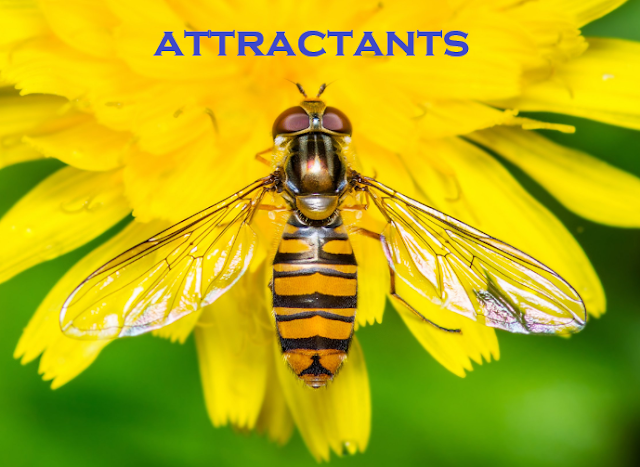Attractants in Entomology (Definition, types and uses)
Definition of Attractants in Entomology
A chemical which causes the insect to make an oriented movement towards its source is known as attractant.
Many insect depend for their survival follow an odour trial to a source of food to host plant and animals to the opposite sex or to the right place to lay eggs. Frequently they can be attracted by means of a chemical to a trap for detection purpose to a toxicant for control of injurious population. Such chemicals or substances are regarded as attractants.
The main functions of attractants is to attract insect towards them. Attractants may be other than chemicals. e.g. Sound which can be used to attract mosquito. In this case sound of female mosquito is produced and towards which male mosquito is attracted.
Types of Attractants in Entomology
Attractants may be of following types
A. Pheromones.
B. Food lures.
C. Oviposition lures.
A. Pheromones in Entomology
The term pheromone was defined by Karlson and Butenandt (1959) to represent those chemicals that are secreted into the external environment by an animal and that elicit a specific reaction in a receiving individual of the same species. Pheromones are also known as ectohormones. Example of artificial pheromone are Geranil, Eugenol etc.
Types of Pheromones in Entomology
1. Sex pheromone.
2. Alarm pheromone.
3. Trailmarking pheromone.
4. Aggregation pheromone or Arrestants.
1. Sex pheromones
The chemicals or pheromones that attract other insects towards them for mating are known as sex pheromones. Usually female insect secret sex pheromone and males attracted towards them. In over 150 species of insects, females have been found to release sex pheromones and about 50 species males produce. Most Lepidoptera female insect secrets sex pheromones. But some lepidopterous male insect can do this. e.g. The male of the cabbage looper produces sex pheromones. Usually different insect species secrets different sex pheromones. For example, monarch butterfly produces a sex pheromone named; trans, trans 10hydroxy3,7dimethyl2,6decadienoic acid. Queen bee produces, 9keto2decenoic acid.
2. Alarm pheromones
Alarm pheromones are those by which insects give warning signals to the other insects. In Polistes exclamans, alarm pheromones are also used as an alert to incoming predators. Social insect like honey bee, ants secret these pheromones. e.g. Ant produces, transβFarnesene.
3. Trailmarking pheromones
Social insects commonly use trail pheromones. These are substances of low persistence elaborated by foraging ants and termites. They secret this pheromone on the way as a trail marker following which the other insects move on the same way. The ant (formica rufa) appears to use formic acid as a trail marker. The major trail marking pheromone of the Texas leaf cutting ant (Atta texana) is Methyl 4methylpyrrole2 carboxylate. Insect can be controlled by using these type of artificial pheromone.
4. Aggregation pheromone or arrestants
These are chemicals or chemical combination that cause insect to aggregate or congregate. Aggregation pheromones are released by one gender of a species to attract individuals (both sexes) of the same species in order to exploit a specific resource (food, appropriate mating site, etc.). Maleproduced sex attractants often are referred to as aggregation pheromones because they typically result in the arrival of both sexes at a calling site. Aggregation pheromones have been found in members of the Coleoptera, Diptera, Hemiptera, Dictyoptera, and Orthoptera. The aggregation pheromone of khapra beetle (Trogoderma granarium), is reported to be a mixture of fatty acid esters, methyl and ethyl oleate, ethyl palmitate, ethyl stearate and ethyl linoleate.
B. Food lures in Entomology
These are natural chemical substances present in many plant or animal host which direct the insect pest towards suitable site for feeding. Food lures may function as olfactory stimulants, producing orientation behaviour in which the insect travels upwind to the source in a manner, similar to the search for a source of sex pheromones. Specific example of food lures include 3hexen2ol for the silkworm (Bombyx mori), sugar and propiononitrile for the housefly (Musca domestica), Coumarin for the sweet clover weevil etc.
By using food lures jute hairy caterpillar moth can be brought to the field of aus rice where they will lay eggs. After hatching the larvae will die due to lack of food.
C. Oviposition lures in Entomology
These are natural chemical substances that control the selection of sites for oviposition by the adult female. By using these chemicals, adult female insect can be lured to lay egg in undesirable place where their larvae will die due to want of food. For example, pmethyl aceto phenone for the rice stem borer. By using this chemical substances, the adult female of rice stem borer can be brought to the jute field to lay egg where their larvae will die.
Uses of pheromone in pest control/uses of Attractants in Entomology
Pheromone may be used in pest control program in two possible ways
1. Population density survey: Population density of a place or field can easily be known by using pheromone. As a result, the other control measure can be taken easily. Therefore, pheromone can be used to help insect control program.
2. Direct behavioural control: Pheromone can be used in direct behavioural control. Behaviour may be
♦ Stimulational behaviour.
♦ Inhibitional behaviour.
In control insect, using pheromone insect should be oriented. In causing orientation pheromone, alone may be an orientation source or pheromone plus light can be used together. The later will give more effective result in causing orientation. The insect should be oriented to;
• An inappropriate host.
• A trap.
• Chemical source.
• Sterilization source.
• Preventive orientation.
Sometimes insect secrets preventive chemical substances by which an insect informs others to keep away. This pheromone is known as preventive orientation.
